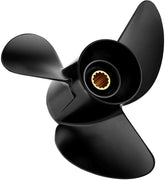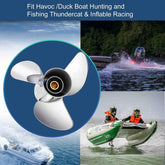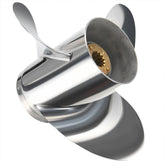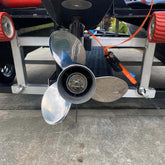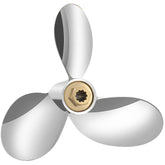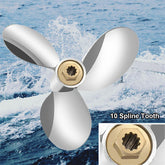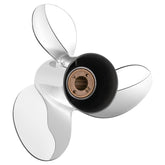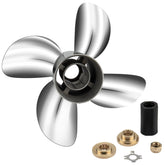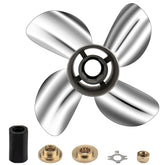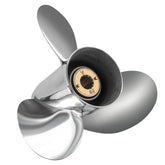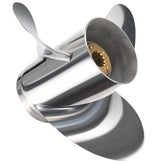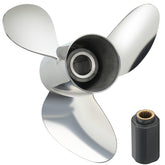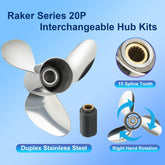Mercury Prop Selector Guide — Matching Props to Mercury Outboards
Why the right propeller for MERCURY matters more than you think
A propeller is the single mechanical part that translates engine power into motion through water. For Mercury outboards — from small 4-6 HP kickers to big 300 HP four-strokes — the correct propeller changes how the boat planes, how quickly it gets on plane, how the engine breathes at wide-open throttle (WOT), and how much fuel it burns.
This guide uses real VIF product table data (examples included below) and practical field-testing methods so you can match a propeller for MERCURY to your exact engine, boat, and mission. No fluff. No guessing. Just clear, actionable selection logic tuned for North American boaters and fleet operators.
How to read a Mercury prop list (what each column really means)
Key columns you’ll find in a VIF / POLASTORM product table
-
Engine HP & model/year group — Use this first. It narrows your choice to props designed to work with the engine’s power band and lower unit gearcase.
-
OEM part / POLASTORM No. — Matches the VIF model to factory references; handy for warranty and replacement.
-
No. Blade — 3, 4, sometimes 5. Blade count controls acceleration vs. top speed and low-speed grip.
-
Diam. (Diameter) — Affects load capacity and how much water the prop moves.
-
Pitch — The theoretical distance (in inches) the prop moves forward per revolution. Bigger pitch = lower RPM for a given speed.
-
Rotation (RH/LH) — Right-hand (RH) or left-hand (LH). Twins and counter-rotating setups must be matched precisely.
-
Material (Aluminum / Stainless) — Durability and stiffness tradeoffs. Stainless holds shape and transmits more power but costs more.
Real VIF examples (pulled from your product sheet)
These sample rows are direct, real-world picks inside your file so you can see what we mean:
-
4–6 HP group (portable outboards): POLASTORM 9057-3078-06 — 3-blade, 7.8" diameter, 6" pitch, RH. A common lightweight aluminum option for small skiffs and transoms.
-
8–9.9 HP group: POLASTORM 9057-3085-06 — 3-blade, 8.5" diameter, 6.5" pitch, RH. Good for small planing hulls where bite is priority.
-
25–30 HP group (3" gearcase): OEM 48-896890A10 / POLASTORM 2857-3099-09 — 3-blade, 9.9" diam, 9" pitch, RH. Typical recreational fit for family pontoons and bass boats.
-
Stainless example (6–15 HP group): POLASTORM 1219-3093-09 — 3-blade, 9¼" diam, 9" pitch, RH. Stainless for durability where shape retention matters.
-
4-blade example (Stella Series): POLASTORM 9857-4087-05 — 4-blade, 8.7" diam, 5" pitch, RH. Better hole-shot and low-speed handling.
Keep these example rows handy while you follow the selection workflow below.
Start with the mechanical match first
Confirm spline, hub and rotation before you think pitch
-
Spline count and shaft diameter must match the lower unit or the prop simply won’t seat or it will damage the splines. VIF tables include OEM references and hub notes — filter these first.
-
Hub type (elastomer insert style, Flo-Torq equivalents, interchangeable hub kits) determines how the prop behaves under shock loads. Match the hub type on record for your Mercury lower unit.
-
Rotation: single-engine boats use RH as standard. Twins often use contra rotation (one LH). Don’t guess; check the VIF row in the sheet for RH/LH.
A correct mechanical fit eliminates half the common “prop doesn’t work” failures.
Matching prop features to mission (practical pairings)
Small tenders & portable outboards (2–15 HP)
Mission: maneuvering, trolling, light planing.
Recommendation: small-diameter, lower-pitch 3-blade aluminum props (examples: 7.8"–9¼" diam with 6–9" pitch). These are affordable, easy to repair, and give quick acceleration from rest.
Bass boats and performance runabouts (25–150 HP)
Mission: quick planing, high top speed, clean cruise.
Recommendation: stiffer stainless 3-blade props for best power transfer at WOT. Choose pitch so your Mercury engine's WOT RPM lands in the recommended factory band under typical load.
Example: for a 25–30 HP outboard, a 9.9" × 9" (3-blade) is a common VIF starting point — test and tweak ±1" pitch depending on actual WOT RPM.
Pontoons, tritoons, deck boats and towing applications
Mission: heavy loads, better hole-shot, low-speed control.
Recommendation: 4-blade configurations or higher-area 3-blade designs. These trades sacrifice a little top speed but give faster plane time, less slip, and more consistent steering in choppy conditions. VIF’s Stella Series 4-blade entries are examples meant for this mission.
Large outboards and high-speed craft (150–300 HP)
Mission: sustained high speed and tight throttle response.
Recommendation: high-quality stainless props tuned in pitch and diameter to the engine model. When Hertz and tenths of knots matter, test multiple pitch options and record the WOT RPM each time.
Use this propeller for MERCURY calculator — practical formulas
The no-nonsense theoretical speed check
Theoretical Speed (mph) = (RPM × Pitch in inches) ÷ 1056
That’s theoretical; real life includes slip. Calculate slip from a test run:
Slip = (Theoretical Speed − Measured Speed) ÷ Theoretical Speed
If your WOT RPM is above Mercury’s recommended range → pitch is too low (engine over-revving).
If your WOT RPM is below range → pitch is too high (engine lugging).
Reverse calculation to pick a starting pitch
If you know the WOT RPM you want and the speed you expect:
Pitch (in) ≈ (Desired Speed × 1056) ÷ RPM ÷ (1 − expected slip)
Use expected slip of 0.15–0.40 depending on hull type. These formulas are how we turn data from the VIF sheet into a testable next choice.
A repeatable field test routine (so your decisions aren’t guesses)
-
Start with the prop that matches spline/hub/rotation on the VIF list. Note the POLASTORM number.
-
Load the boat as you normally do (fuel, people, gear).
-
Run to WOT and record WOT RPM and GPS speed.
-
Run a steady cruise and record cruise RPM and speed.
-
Calculate theoretical speed and slip. Check WOT RPM against Mercury’s recommended WOT band.
-
If outside the band, change pitch by 1" increments and repeat. Record everything in a spreadsheet or log.
This method converts a product table into proven settings for your hull.
Blade count and material — practical tradeoffs
-
3-blade (aluminum or stainless): Best balance for top speed and cruise efficiency. Less wetted area = less drag.
-
4-blade: Better hole-shot, better grip for heavy loads, smoother handling at low speeds — excellent for pontoons and tow boats.
-
Aluminum: Lower cost, easier to repair after a ding. Great for casual recreational boats.
-
Stainless: Stiffer, more efficient at high RPM and high loads; recommended for performance boats and commercial use.
VIF product lines in your file show both aluminum and stainless rows for nearly every Mercury HP band — keep a stainless spare for performance runs and an aluminum spare for everyday use or rentals.
Common problems, how to read the data to avoid them
-
Over-revving after a prop swap — check pitch first. The VIF table pitch column tells you the starting point; if you’re outside RPM limits, go ±1" pitch.
-
Line/rope damage and spun hubs — if your product list includes interchangeable hub kits (POLAFLEX etc.), keep a hub kit on the boat for fleets. The VIF sheet has hub kit rows you can cross-reference.
-
Shaft seal problems — fishing-line wraps are the most frequent cause. Before installing a new prop, inspect the shaft for grooves and clean thoroughly.
Inventory & procurement logic for Mercury-driven fleets
From the VIF sheet you can build a compact “fleet pack” by HP band:
-
For each HP band keep: two pitch variants (standard and +1 pitch), one aluminum and one stainless option, two hub inserts, spare prop nuts and cotter pins.
-
Example starter pack entries (drawn from your sheet): 4–6 HP (POLASTORM 9057-3078-06), 8–9.9 HP (9057-3085-06), 25–30 HP (2857-3099-09), 6–15 HP stainless (1219-3093-09).
That small rule set covers most service calls and cuts downtime.
Maintenance and field repair notes
-
Carry a spare aluminum prop for quick swaps; aluminum can be hammered back into service after light strikes.
-
Keep spare hub inserts and shear pins for models you run most. Your sheet includes "INTERCHANGEABLE HUB KITS" and "Hub kits Cross Reference" tabs — use those to map hubs to parts.
-
Replace a prop nut and cotter pin after each service event; re-check torque after the first run.
FAQ
How do I choose the right prop for my Mercury 25 HP outboard?
Start at the VIF list: find rows under the 25–30 HP group. In the VIF sheet a common example is a 3-blade 9.9" × 9" (POLASTORM 2857-3099-09). Fit it, test WOT RPM under normal load, and adjust pitch in 1" steps until WOT RPM sits in the recommended band.
3-blade or 4-blade propeller for MERCURY — which one should I pick?
If you want top speed and cruise efficiency pick a 3-blade. If your use includes heavy loads, frequent towing, or you want a sharper hole-shot/pull from a standstill, pick a 4-blade.
What does the POLASTORM number tell me?
It’s your VIF SKU / part reference. Use it to order the exact replacement or to match the OEM part number in your records. Example: 9057-3078-06 corresponds to a 3-blade 7.8" diam × 6" pitch prop for small portable engines.
How is pitch related to WOT RPM?
Pitch and RPM are inversely related for a given speed: higher pitch lowers RPM; lower pitch raises RPM. Measure WOT RPM and compare it to your engine’s WOT band — adjust pitch to bring WOT RPM into the correct range.
What’s the difference between an impeller and a propeller?
A propeller is the external device moving the boat through water. An impeller is part of a jet unit or water pump and moves water for cooling or PWC thrust. They are different parts and not interchangeable. (Impeller vs propeller explained in your product notes.)
Do I need stainless or aluminum propeller for MERCURY in saltwater?
Stainless is best for durability and shape retention in saltwater. Aluminum can be used, but expect more frequent inspections and possible repairs after hits.
Closing — how to convert the VIF spreadsheet into a live selector
You already have the right raw material in your Excel: grouped HP bands, blade count, pitch, diameter and POLASTORM part numbers. Turn those table rows into a one-page selector widget (or a simple Shopify product block) that:
-
Asks the user for engine HP and model/year.
-
Filters by spline/hub and rotation.
-
Presents 2–3 VIF prop options by mission (cruise, towing, performance) with part numbers and a short rationale.
-
Offers a printable test checklist (WOT RPM, GPS speed, slip calculation).
If you give me a CSV extract of Mercury rows (or allow me to read more of the sheet), I’ll generate that product selector block formatted for direct copy-paste into Shopify or WordPress, and prefill the recommended VIF SKUs per HP band.
Meta description:


